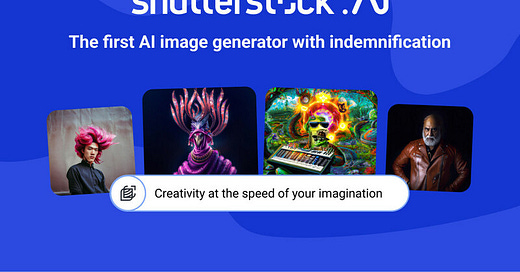Shutterstock Follows Adobe and Offers Legal Protection from Generative AI Copyright Claims
The many costs of change
Adobe sees a new technology era emerging and is determined to be a leader that reaps the rewards of bold action and simultaneously avoids the fate so often chronicled in The Innovators Dilemma. Shutterstock correctly sees an existential risk from this technology and is looking for a solution. Both companies see the benefit of reducing barriers to adoption.
Large companies are known for their brands, manufacturing plants, complex supply chains, and, in good times, generating a lot of revenue. A defining theme is also managing risk. Few of them will see generative AI as core to their business and will likely forgo its use to avoid lawsuits. Indemnity from lawsuits is a way to reduce risk.
Shutterstock Snaps Into AI
Shutterstock is one of the largest stock photo and creative asset licensing solutions with more than 450 million items for purchase. In October 2022, the company introduced a generative AI text-to-image solution based on OpenAI’s DALL-E. It acknowledged at the time that there may be some questions about what is defined as fair use of artwork employed in training generative AI models.
“The mediums to express creativity are constantly evolving and expanding. We recognize that it is our great responsibility to embrace this evolution and to ensure that the generative technology that drives innovation is grounded in ethical practices,” said Paul Hennessy, Chief Executive Officer at Shutterstock.
The product launch was accompanied by the formation of a contributor fund, which pays out licensing royalties to artists that contributed artwork to the AI training databases. Last week the company said the fund has “compensated hundreds of thousands of artists for the role their content IP has played in training Shutterstock's generative technology, with anticipated payments to millions more, and has provided artists with ongoing royalties tied to licensing activity for newly generated assets.”
Shutterstock Offers Indemnity
The new indemnity announcement formalizes that the company is offering users full indemnity for the use of generative AI artwork created through the service, much like it does for stock artwork and design models.
Shutterstock … today announced its offering to provide Enterprise customers with full indemnification for the license and use of generative AI images on its platform. Shutterstock will fulfill indemnification requests on demand via human review with the intent to protect its customers against potential claims related to their use of generative AI images created and licensed on shutterstock.com.
…
"We're at an inflection point in the use of generative AI technology as business professionals are seeking more assurance around their rights to legally use AI-generated content, and creators of original content want to ensure their work is fairly licensed for use," said John Lapham, General Counsel at Shutterstock. "We have always sought to manage risk for our customers and are uniquely positioned to bring a commercially viable image generator to market and indemnify its outputs, because of our relationship with artists and intimate understanding of the complexities of licensing."
During a video interview with VentureBeat, Jeff Cunning, VP of product at Shutterstock, said:
“One of the biggest things that our customers have wanted from us is the same commercial licensing confidence that they get for other Shutterstock content.”
….
He added that the company had already announced a full indemnity for licensing generative AI images for specific client use cases at Shutterstock’s global conference in May, but now the offering is being rolled out to all customers with an enterprise business account.
Adobe Follows a Similar Path
Adobe announced similar protections at the end of June. This is just one more cost of doing business when it comes to generative AI.
“With Firefly, Adobe will also be offering enterprise customers an IP indemnity, which means that Adobe would protect customers from third party IP claims about Firefly-generated outputs.”
Shutter Stock to Offer OpenAI DALL-E Image Generation
Shutterstock announced this week that it has partnered with OpenAI to introduce a AI text-to-image solution for its customers. This comes just a month after Getty Images decided to ban AI-generated art altogether. Sailing in Different Directions Getty Images may not think of Shutterstock as a direct rival. Shuttersto…






